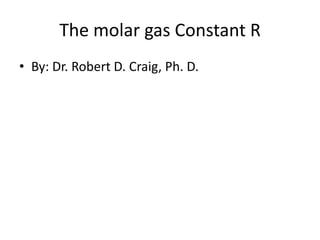
The new gas law
- 1. The molar gas Constant R • By: Dr. Robert D. Craig, Ph. D.
- 2. Relationship Between the Ideal-Gas Equation and the Gas Laws • Boyle's law, Charles's law and Avogadro's law all represent special cases of the Ideal Gas law (equation) • If the quantity of gas and the temperature are held constant then: pV = nRT V = nRT / p V= (nRT) * (1/p) V= constant * (1/p) (Boyle's law)
- 3. Relationship Between the Ideal-Gas Equation and the Gas Laws • If the quantity of gas and the pressure are held constant then: pV = nRT V = (nR/p) * T V = constant * T (Charles's law)
- 4. Relationship Between the Ideal-Gas Equation and the Gas Laws • If the temperature and pressure are held constant then: pV = nRT V = n * (RT/p) V = constant * n (Avogadro's law)
- 5. The 'General"case... • Suppose everything changes at once. • One thing we are very sure of is that the gas constant, R, is in fact a constant. If we label the properties of the state of the gas initially by the subscript 1, then the state of the gas initially is defined by: • { n1, p1, V1, T1 }
- 6. . • Later, the gas will be in a different state, defined by new variables: • { n2, p2, V2, T2 }
- 7. For any change in state of the gas, (pV/nT) = R remains unchanged, so
- 8. The Ideal Gas Equation of State The Ideal Gas Equation of State The three 'historical' gas laws are relationships between two physical (state) properties of a gas, with two other properties constant. (Why does it take just four properties to define the state of a gas?):
- 9. The Ideal Gas Equation of State.
- 10. . These relationships can be combined into a single relationship to make a more general gas law:
- 11. . If the proportionality constant is called "R", then we have:
- 12. . Rearranging to a more familiar form: This equation is known as the Ideal-Gas Equation of State
- 13. . This equation works (approximately) for all gases regardless of their Chemical Identity!
- 14. . The constant R is called the UNIVERSAL GAS CONSTANT, and is a fundamental conversion factor. When we first contact an advanced alien civilization, they will know a value of R but it will convert their temperature to their energy units, and will not be of great use to us. We already have enough different units for R (see below).
- 15. . • The value and units of R depend on the units used in determining P, V, n and T. • Temperature, T, must always be expressed on an absolute-temperature scale (K) (otherwise Charles' Law doesn't work)
- 16. . • The quantity of gas, n, is normally expressed in moles. This is just a baker's dozen for expressing the number of molecules
- 17. Units for the Gas Constant, R Units Numerical Value L . atm / mol . K 0.08206 cal / mol . K 1.987 J / mol . K 8.314 m3 . Pa / mol . K 8.314 L . torr / mol . K 62.36
- 18. Density • Mass Density has the units of mass per unit volume. • Number Density has the units of molecules (moles) per unit volume and is directly derived from the Ideal Gas Equation of State: • pV = nRT (n/V) = p/RT
- 19. . • (n/V) is the number density and has the units of moles/liter. If we know the molecular mass of the gas, we can convert this into grams/liter (mass/volume). The molar mass (M) is the number of grams in one mole of a substance. If we multiply both sides of the above equation by the molar mass:
- 20. where d is the number of grams per unit volume, or the mass per unit volume (which is the MASS DENSITY)
- 21. Use of the Ideal Gas Equation • Numerical Example: 1.00 mol of gas at 1.00 atm of pressure at 0.00°C (273.15 K) occupies what Volume? • pV = nRT V = nRT/p V = (1.00 mol)(0.0821 L atm/mol K)(273.15 K) / (1.00 atm) Therefore: V = 22.4 L
- 22. Relationship Between the Ideal-Gas Equation and the Gas Laws • Boyle's law, Charles's law and Avogadro's law all represent special cases of the Ideal Gas law (equation) • If the quantity of gas and the temperature are held constant then: pV = nRT V = nRT / p V= (nRT) * (1/p) V= constant * (1/p) (Boyle's law)
